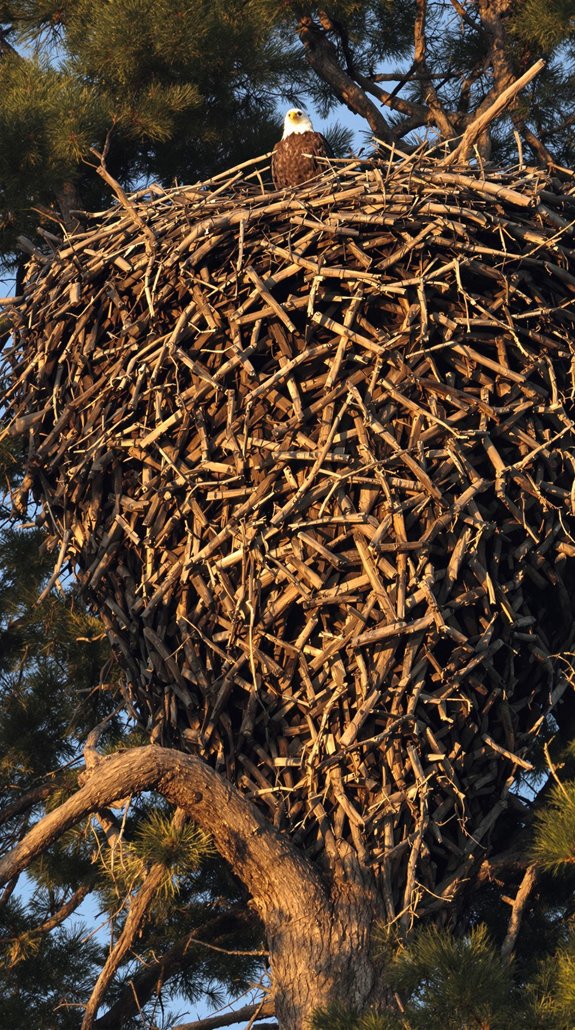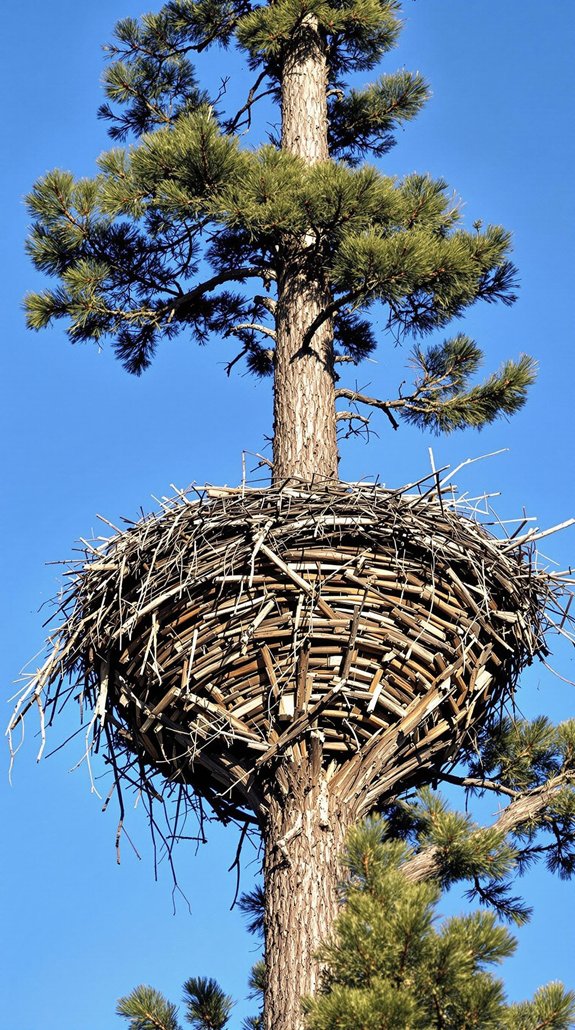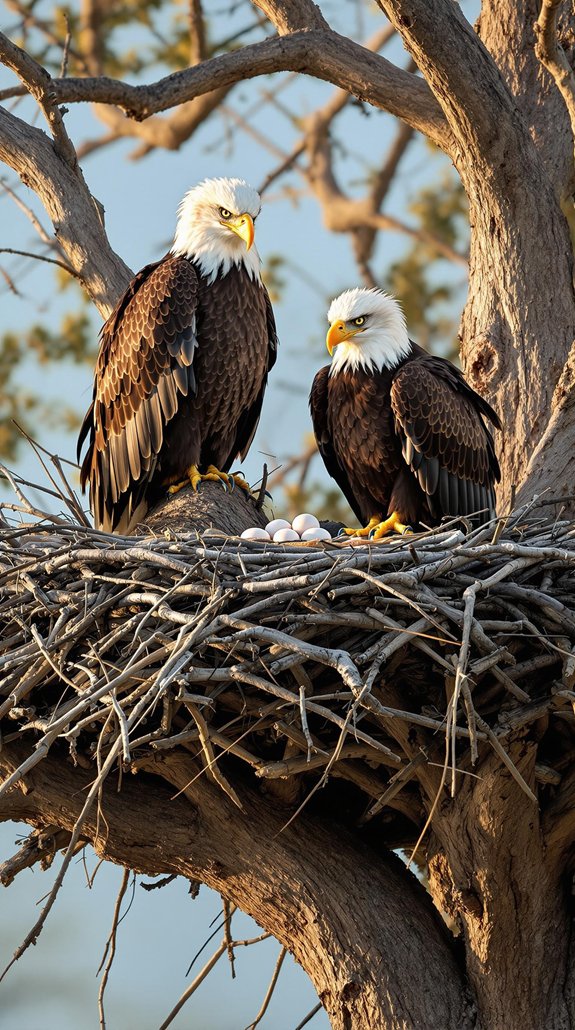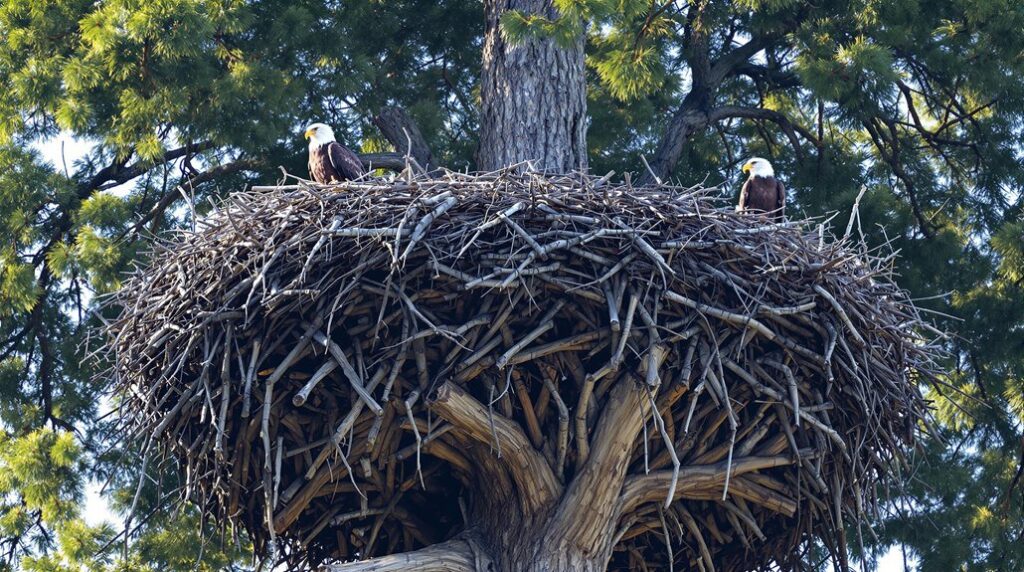You’ll find bald eagles building massive stick nests that start around 5-6 feet wide but can grow to weigh over a ton through years of additions. They prefer tall trees near water—within 200 meters when possible—choosing species like Douglas-fir in the Pacific Northwest or Sitka spruce in Alaska. Their 8-16 week breeding preparation involves both parents renovating nests with large branches, then lining them with softer materials. Discover how these remarkable raptors master their intricate construction process.
Nest Size and Structure Dimensions

If you’ve ever spotted a bald eagle nest, you’d immediately notice its massive proportions compared to typical bird nests. These structures typically measure 4–7 feet wide and 3–6 feet tall, though average nests span 5–6 feet in diameter and 2–4 feet in height.
Bald eagle nests dwarf typical bird nests, measuring 4–7 feet wide and 3–6 feet tall.
You’ll find some record-breaking examples reaching extraordinary dimensions—up to 13 feet deep, 8.2 feet wide, and weighing 1.1 tons. In 2021, researchers documented one measuring 7.25 feet across.
The nest’s shape varies from cylindrical to conical, depending on tree structure and material distribution. Since branches often slope and eagles don’t build perfect cones, you’ll notice height and weight measurements can vary greatly. Using calculations based on dry oak weight, scientists estimate that large nests like the North nest can weigh approximately 2,187 pounds.
First-year nests start smaller but expand through decades of continuous additions.
Breeding Cycle Timeline and Phases
When winter shifts to spring, bald eagles begin an intricate breeding cycle that spans several months and involves distinct behavioral phases.
You’ll observe the preparation phase lasting 8-16 weeks as hormones trigger territorial behaviors and nest reinforcement. During the sexual subphase, you’ll notice copulation intensifying to four times daily while females develop 1-3 eggs.
Once eggs are laid, the parental phase begins with 35-day incubation periods where females handle 90% of brooding duties.
After hatching, you’ll watch eaglets progress through rapid structural growth, developing from helpless hatchlings to fledglings in three months.
They’ll practice flapping at 6-7 weeks before taking their maiden flight. Even after fledging, young eagles depend on their parents for another 4-6 weeks while adults simultaneously undergo post-breeding molt. Following this termination phase, gonads regress as the birds transition from reproduction to feather replacement.
Preferred Tree Species by Region

Across North America’s diverse ecosystems, bald eagles demonstrate remarkable adaptability in their tree species selection, though you’ll find they consistently favor the tallest, most stable options available in each region. These magnificent birds construct enormous nests measuring 5 to 6 feet in diameter and 2 to 4 feet tall, making structural support crucial in their tree selection.
In the Pacific Northwest’s western forests, you’ll see Douglas-fir dominating nesting sites at 70-74%, with Sitka spruce serving as the secondary choice. East of the Cascades, ponderosa pine becomes the clear preference at 71-81% usage.
If you’re observing Alaska’s old-growth forests, Sitka spruce accounts for 78% of nests, while western hemlock comprises 20%.
Florida’s eagles adapt to coastal mangroves and inland slash, longleaf, and loblolly pines. In urban environments, you’ll notice black cottonwood hosting 62% of nests, with Douglas-fir at 30%.
Wyoming’s eagles select mature cottonwoods along rivers and ponderosa pines in mountainous areas.
Nesting Site Selection Criteria
While bald eagles show flexibility in their tree species selection, they’re remarkably consistent in their site selection criteria, prioritizing water proximity above all other factors.
Bald eagles prioritize waterfront locations above all else when selecting their nesting sites.
You’ll find most nests within 1.6 kilometers of waterfront, with one-third positioned within 200 meters. Eagles require unobstructed water views—85% of nests feature this essential characteristic.
You’ll notice eagles select the uppermost portions of trees, placing 89% of nests in the top 9 meters. They prefer open-canopy forests with less than 40% closure, allowing clear sightlines for hunting.
The trees they choose typically exceed 30 meters in height and 90 centimeters in diameter. Eagles avoid dense human development and rarely nest beyond 3.2 kilometers from water.
Their strategic placement guarantees ideal foraging visibility while maintaining overhead cover for sun protection.
Construction Materials and Building Techniques

Bald eagles construct their massive nests using surprisingly simple materials, with large sticks and branches forming the primary structural framework.
You’ll watch both eagles gather ground debris and tree branches annually, creating an initial triangle formation with angled support branches. They’ll interlock sticks through the nest’s center and perimeter, periodically tamping and shaking the structure to compress layers.
As construction progresses, they’ll introduce circular patterns once reaching about 0.3m depth.
You’ll notice they add 15-20 liters of fill material to the center for stabilization, then line the interior with soft materials like moss, grass, or seaweed. Eagles may transport sticks from as far away as a mile to gather the best materials for their nest construction. Through continuous layering, they’ll build nests typically measuring 1.5-1.8m in diameter and 0.6-1.2m deep, though some reach record sizes up to 4m deep and exceed one ton.
Territory Size and Defense Strategies
Once eagles establish their nests, they’ll defend territories averaging one mile in diameter, though this size fluctuates dramatically based on food availability and habitat quality.
You’ll find these territories range from 0.6 to 1.2 square miles, expanding markedly in food-scarce regions where eagles need larger ranges to secure adequate resources.
Within each territory, you’ll typically observe 1.5 nests on average, with pairs maintaining multiple breeding sites as backup options.
Eagles strategically position these nests within 1.8 miles of water sources, ensuring reliable prey access.
They’ll use elevated surveillance posts to monitor boundaries and aggressively display against intruders.
Northern populations migrate seasonally, while southern eagles remain residential, continuously defending their established territories through prolonged nest reuse and persistent pair bonds. The largest recorded nest reached 2.9 meters in diameter and required decades of continuous construction.
Parental Roles During Breeding Season

After establishing and defending their territories, eagles must coordinate their efforts to successfully reproduce and raise offspring.
You’ll observe males initiating the breeding process by starting nest construction 1-3 months before egg-laying, while females enhance these structures with specific material arrangements. Both sexes share incubation duties over the 35-day period, alternating between warming eggs and hunting. During this phase, females primarily hunt while males guard the territory and provide supplemental food.
Eagle pairs demonstrate remarkable teamwork during breeding season, with males building nests while females fine-tune arrangements before sharing incubation responsibilities.
Once chicks hatch, you’ll see both parents actively hunting and delivering prey throughout the 10-14 week nestling period. The female develops a brood patch to enhance warmth transfer during the critical incubation period.
Even after juveniles fledge by late August, parents continue providing food and teaching essential foraging skills until offspring achieve independence around 4-5 years of age.
Annual Nest Renovation Patterns
Each year, bald eagles undertake extensive renovations to maintain and expand their massive nesting structures.
You’ll observe renovation beginning as early as November, though most pairs start between January and March to prepare for breeding season. Both males and females contribute materials like sticks, twigs, and moss, with females typically arranging the structure.
They’ll spend one to three months on construction, depending on existing nest condition.
You’ll notice nests growing larger each year, sometimes reaching nine feet in diameter and weighing two metric tons. Some pairs alternate between multiple nests to reduce wear.
They’ll add soft lining materials for insulation and incorporate conifer sprigs during incubation.
Storm damage may require mid-season repairs to maintain structural integrity throughout the nesting period. Eagles continue using and repairing nests yearly, even after their young have successfully fledged and left the territory.
Geographic Variations in Nesting Locations
Geography dramatically shapes where bald eagles choose to establish their nests, with distinct regional preferences reflecting local ecosystems and available resources.
You’ll find coastal British Columbia hosting the highest densities, where marine ecosystems provide abundant prey. In northern regions like Alberta, Saskatchewan, and Manitoba, eagles dominate boreal forests with extensive waterways.
Florida’s populations favor deciduous trees and mangroves in the Everglades, while some eagles adapt to cacti in Arizona’s Sonoran Desert.
You’ll notice northern eagles prefer sturdy evergreens at 60-100 feet elevations, while southern birds utilize varied vegetation closer to water sources. Recent urban expansion has brought nesting into cities like Toronto, demonstrating remarkable adaptability. These eagles show exceptional resilience in harsh conditions, adapting their nesting strategies to survive challenging environmental circumstances.
Most nests remain within one mile of coastlines, rivers, or large lakes regardless of geographic location.
Population Recovery and Breeding Success Rates
The bald eagle’s remarkable comeback from near-extinction represents one of North America’s greatest conservation triumphs, with current populations reaching an estimated 316,700 individuals including 71,400 nesting pairs.
You’ll find that breeding success rates vary greatly based on habitat quality, particularly the availability of aquatic foraging areas within 5 kilometers of nests. Eagles nesting near limited water sources show 33-50% success rates and produce only 0.5-0.67 eaglets per attempt. In contrast, pairs with access to contiguous aquatic zones achieve much higher productivity.
Central California exemplifies this recovery, with nesting pairs increasing 19% annually from 4 pairs in 2011 to 31 in 2024, now exceeding federal recovery benchmarks established in 1986. This dramatic increase follows the recovery pattern seen in other states, including New York where nesting pairs grew from one pair in 1972 to approximately 600 pairs by 2014.
References
- https://www.fws.gov/Alaska-eagle-nesting
- https://www.elfruler.com/?page_id=3208
- https://www.pa.gov/agencies/pgc/wildlife/discover-pa-wildlife/bald-eagles/baldeaglenesting.html
- https://www.audubon.org/field-guide/bird/bald-eagle
- https://en.wikipedia.org/wiki/Bald_eagle
- https://www.raptorresource.org/2022/10/26/how-big-is-a-bald-eagles-nest/
- https://eagles.org/what-we-do/educate/learn-about-eagles/bald-eagle-nests/
- https://journeynorth.org/tm/eagle/annual/facts_nest.html
- https://journeynorth.org/tm/eagle/NestAbout1.html
- https://www.allaboutbirds.org/guide/Bald_Eagle/lifehistory

Erzsebet Frey (Eli Frey) is an ecologist and online entrepreneur with a Master of Science in Ecology from the University of Belgrade. Originally from Serbia, she has lived in Sri Lanka since 2017. Eli has worked internationally in countries like Oman, Brazil, Germany, and Sri Lanka. In 2018, she expanded into SEO and blogging, completing courses from UC Davis and Edinburgh. Eli has founded multiple websites focused on biology, ecology, environmental science, sustainable and simple living, and outdoor activities. She enjoys creating nature and simple living videos on YouTube and participates in speleology, diving, and hiking.

